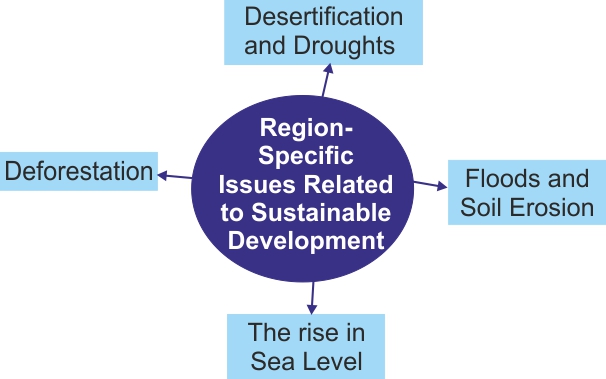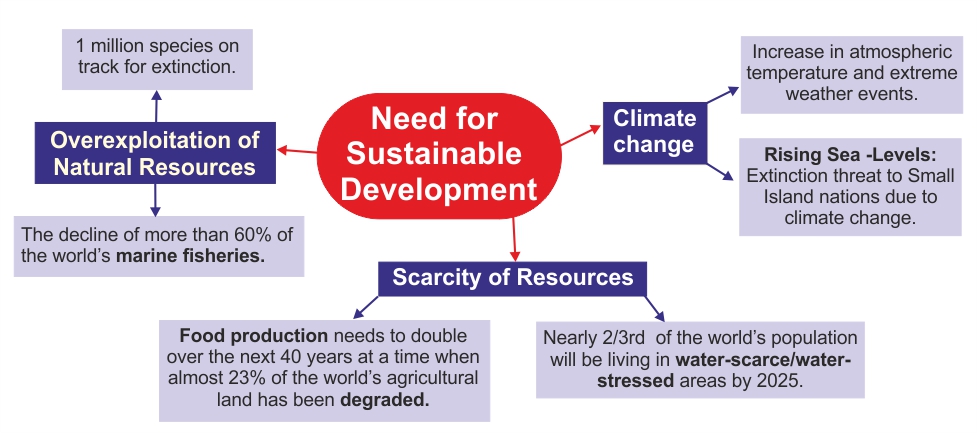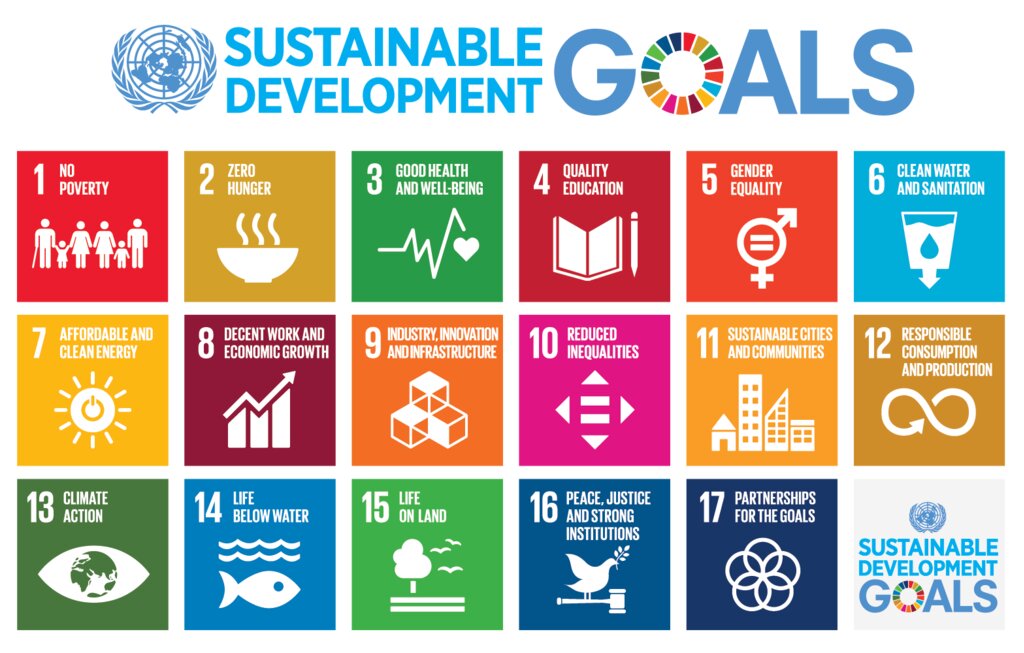Biodiversity & Environment
Sustainable Development
- 20 Jan 2020
- 17 min read
Why in News
- NITI Aayog has released the second edition of the Sustainable Development Goals (SDGs) India Index (SDG Index 2.0).
- The index documents the progress made by India’s States and UTs towards achieving the 2030 SDG targets.
- 2020 will be the 5th anniversary of the adoption of SDGs by the United Nations (UN).
What is Sustainable Development?
- ‘Development which meets the needs of the present without compromising the ability of future generations to meet their own needs’.
- This most widely accepted definition of Sustainable Development was given by the Brundtland Commission in its report Our Common Future (1987).
- Sustainable development (SD) calls for concerted efforts towards building an inclusive, sustainable and resilient future for people and planet.
Core Elements of Sustainable Development
- Three core elements of sustainable development are economic growth, social inclusion and environmental protection. It is crucial to harmonize them.
- Sustainable economic growth, achieving sustainable livelihood, living in harmony with nature and appropriate technology are important for sustainable development.
- Environmental Sustainability:
- It prevents nature from being used as an inexhaustible source of resources and ensures its protection and rational use.
- Aspects such as environmental conservation, investment in renewable energy, saving water, supporting sustainable mobility, and innovation in sustainable construction and architecture, contribute to achieving environmental sustainability on several fronts.
- Social Sustainability:
- It can foster gender equality, development of people, communities and cultures to help achieve a reasonable and fairly-distributed quality of life, healthcare and education across the Globe.
- Economic Sustainability:
- Focuses on equal economic growth that generates wealth for all, without harming the environment.
- Investment and equal distribution of economic resources.
- Eradicating poverty in all its forms and dimensions.
Integration of Scientific and Traditional knowledge
- If the people are able to contribute their local resources and practices into the process of change, the development becomes not only sustainable but also gets accelerated.
- Combined traditional and scientific knowledge is called community knowledge. Moving towards SD in many areas will require community knowledge.
- Indigenous knowledge is also a potential source for the conservation of biodiversity.
- Significance of traditional knowledge has been recognised in India through initiatives such as National Ayush Mission (NAM) and the Traditional Knowledge Digital Library (TKDL).
Global issues Related to Sustainable Development
- Inequitable growth of national economies (North-South Divide)
- Loss of Biodiversity: Despite mounting efforts over the past 20 years, the loss of the world’s biodiversity continues.
- Climate Change: As a global problem, climate change requires a global solution. Within climate change, particular attention needs to be paid to the unique challenges facing developing countries.
- Tackling climate change and fostering sustainable development are two mutually reinforcing issues.
- Intellectual Property Rights (IPRs): There is a need for welfare for all rich and poor to have affordable access to the results of innovation that can lead to sustainable development.
Global Initiatives on Sustainable Development
- The Stockholm Conference,1972: It was the first step towards putting environmental concerns on the global agenda.
- It resulted in the Stockholm Declaration which contained principles and an Action Plan containing recommendations for environmental policy.
- UNEP was set up in 1972 to serve as a catalyst in developing and coordinating an environmental focus in the programmes of other organisations.
- The Earth Summit, 1992: This was a direct consequence of the Brundtland Commission’s Report. It was held in Rio de Janeiro. The results of the Conference were the following documents:
- The Framework Convention on Climate Change (UNFCCC)
- The Convention on Biological Diversity
- The Statement on Forest Principles
- The Rio Declaration
- Agenda 21
- Kyoto Protocol,1997
- Rio +10, 2002: A 10-year assessment of the Rio outcomes (Rio +10) took the shape of the World Summit on Sustainable Development (WSSD) held in Johannesburg.
- Ramsar Convention, 1971
- The World Heritage Convention, 1972: It identifies and conserves the world’s cultural and natural heritage. It draws up a list of ‘heritage sites’, which are cultural, natural or mixed areas of ‘outstanding universal value’ and therefore need to be preserved for all humanity.
- Convention on International Trade in Endangered Species of Wild Fauna and Flora (CITES), 1973
- Convention on the Conservation of Migratory Species of Wild Animals (CMS), 1979
- Vienna Convention for the Protection of the Ozone Layer, 1985
- Montreal Protocol on Substances that Deplete the Ozone Layer, 1987
- Basel Convention, 1989
- Convention on Biological Diversity,1992
- United Nations Convention to Combat Desertification,1994
- Rotterdam Convention,1998
- Stockholm Convention on Persistent Organic Pollutants,2001
- Global Tiger Forum,1993
- International Whaling Commission,1946
- Minamata Convention,2013
- Climate change mitigation strategies: Carbon sequestration, Carbon sink, Carbon Credit, Carbon trading, Carbon offsetting, Carbon Tax, Geo-engineering.
- United Nations Environment Programme (UNEP)
- UN Commission on Sustainable Development (CSD)
- United Nations Convention on the Law of the Sea (UNCLOS)
- Climate Finance Architecture: Green Climate Fund (GCF), Adaptation Fund (AF) and Global Environment Facility (GEF)
- Reducing Emissions from Deforestation and Forest Degradation (REDD) and REDD+
- Paris Agreement 2015
- The Clean Development Mechanism is a way to reduce greenhouse gases(GHGs ) emissions through efficient and sound technologies.
- Global Alliance for Climate-Smart Agriculture (GACSA)
- Partnership for Action on Green Economy (PAGE)
- Sustainable Development Goals (SDGs):
- To bring sustainable development in the mainstream United Nations (UN) launched the 2030 Agenda for Sustainable Development and SDGs.
- This universal, integrated and transformative agenda aims to spur actions that will end poverty and build a more sustainable world over the next 15 years.
- There are 17 goals and 169 targets specific targets to be achieved by 2030. Reaching the goals requires action on all fronts – governments, businesses, civil society and people everywhere all have a role to play.
- SDGs are not legally binding.
Roadblocks to Global Initiatives
- To reconcile the assertion of ‘sovereignty’, by the member states with the growing environmental interdependence and the need for concerted action.
- For ex: Overcoming the North-South divide is one of the major hurdles facing the international environmental protection regime.
- The ‘North’ world has just over 20% of the world population but consumes 80% of the world’s energy; on the other hand, the ‘South’, comprising of the developing nations of the world is still struggling to provide for the basic needs for its population.
- Methods/ways to monitor and regulate global commons (Oceans, Space and Antarctica). Being nobody’s property may act as a disincentive for protection.
Regional Initiatives
Regional mechanisms are effective means for addressing trans-boundary issues such as atmospheric pollution and pollution of shared rivers and water bodies, which nations are unable to solve on their own. Regional mechanisms involve fewer transactional costs, are less time-taking and have higher chances of success.
- The European Union (EU): It enforced certain environmental principles viz., preventive principle, subsidiarity principle, integrative principle, the polluter pays principle etc.
- ASEAN has numerous environmental legal instruments.
- SAARC adopted Environment Action Plan (1997):
- Comprehensive Framework on Disaster Management 2006-2015 was adopted in 2006 to address the specific needs of disaster risk reduction and management in South Asia.
- SAARC Convention on Cooperation on Environment has been ratified by all member states and entered into force in 2013.
Community Initiatives
A significant initiative towards sustainable development comes directly from the community level. NGOs create linkages between global and local needs and actors. They have played a role in negotiation, monitoring and implementation of environmental law and policy at all levels.
- IUCN, 1948 has helped draft or has provided a secretariat for several important international conventions.
- National Greenhouse Gas Inventories Programme (IPCC-NGGIP)
- The WWF has played a major role in the evolution of the international conservation movement.
- TRAFFIC: The Wildlife Trade Monitoring Network,1976
- Wetlands International
- Greenpeace uses research, lobbying and diplomacy as well as high-profile, ‘on-the-streets’ events, to draw attention to the environmental problems and to raise the level and quality of public debate.
- In India, Biodiversity Act, 2002 is almost completely built on inputs from a network of NGOs working across the country.
- Similarly, the Chipko Movement and Save the Silent Valley Movement were results of community efforts.
Role of Cooperatives in sustainable development
- Cooperative societies connect the people at the grassroots level to the highest level of the government.
- Cooperatives and NGOs help considerably in the upliftment of the socio-economic conditions of the rural poor and also adopt environment-friendly technologies for their functioning and generate awareness among people regarding environmental issues.
- Ex: In India, AMUL became the most successful cooperative movement for the sustainable development of rural poor by launching the Operation Flood.
Progress and Challenges Ahead
- Progress
- As per the Sustainable Development Goals Report, 2019
- Extreme poverty has declined considerably.
- The under-5 mortality rate fell by 49 % between 2000 and 2017.
- Immunizations have saved millions of lives.
- The vast majority of the world’s population now has access to electricity.
- Countries are taking concrete actions to protect our planet: marine protected areas have doubled since 2010.
- Countries are making concerted efforts to address illegal fishing.
- 186 parties have ratified the Paris Agreement on climate change, and almost all have communicated their first nationally determined contributions.
- About 150 countries have developed national policies to respond to the challenges of rapid urbanization, and more than 70 countries and the European Union now have more than 300 policies and instruments supporting sustainable consumption and production.
- A wide range of other actors—international organizations, businesses, local authorities, the scientific community and civil society—have engaged with the SDGs in a manner that generates great hope for the coming decade.
- As per the Sustainable Development Goals Report, 2019
- Challenges
- As per the Sustainable Development Goals Report, 2019
- Increasing inequality among and within countries requires urgent attention.
- 3 out of every 4 stunted children live in Southern Asia and sub-Saharan Africa.
- Young people are more likely to be unemployed than adults.
- Barriers in achieving gender equality.
- Global hunger has been on the rise after a prolonged decline.
- Extreme poverty declined from 36% in 1990 to 8.6% in 2018, but the pace of poverty reduction is starting to decelerate as the world struggles to respond to entrenched deprivation, violent conflicts and vulnerabilities to natural disasters.
- Extreme poverty is three times higher in rural areas than in urban areas.
- 2018 was the fourth warmest year on record. Levels of CO2 concentrations continued to increase in 2018.
- Natural environment is deteriorating at an alarming rate.
- Sea levels are rising.
- Ocean acidification is accelerating. Ocean acidity is 26% higher than in pre-industrial times.
- 1 million plant and animal species are at risk of extinction.
- Land degradation continues unchecked.
- As per the Sustainable Development Goals Report, 2019
Various methodologies have been evolved to monitor the progress of SDGs.
- Sustainable Development Index (SDI), 2019
- It is released by the Sustainable Development Solutions Network (SDSN).
- The SDI seeks to help countries identify gaps that must be closed in order to achieve SDGs by 2030 and to identify priorities for early action.
- India ranked 115 out of 162 countries.
- Global Sustainable Development Report (GSDR), 2019
- It is the first GSDR prepared by the United Nations. It is entitled “The Future is Now: Science for Achieving Sustainable Development”.
- It evaluated progress on the 2030 Sustainable Development Agenda.
- The report finds that the current development model is not sustainable, and the progress made is in danger of being reversed through worsening social inequalities and potentially irreversible declines in the natural environment that sustains us.
- The amount of modern renewable energy in the total global energy supply has increased by an average of approx. 5% annually over the past decade. Meanwhile, since 2009 the price of renewable electricity (solar and wind) has dropped for five years in a row.
Way Forward
- To make the process of sustainable development feasible and operational, it is important to establish a common focus that can integrate the outlook and efforts of various participants in development, worldwide, realising the diversity, in terms of geography, society, economics, level of science and technology capabilities and capacities and education standards/levels.
- Developed countries need to change their production and consumption patterns, including by limiting the use of fossil fuels and plastics, and to encourage public and private investments that align with the SDGs.
- Environmental commons—such as the atmosphere, rainforests and oceans—must be safeguarded as crucial sources of ecosystem services and natural resources. All stakeholders must work together to conserve, restore and sustainably use natural resources.
- The food system must undergo widespread changes to the infrastructure, cultural and societal norms, and policies that are supporting the current, unsustainable, status quo.
- The much deeper, faster and more ambitious response is needed to unleash the social and economic transformation needed to achieve our 2030 goals.
- A far more optimistic future is still attainable only by drastically changing development policies, incentives and actions.








